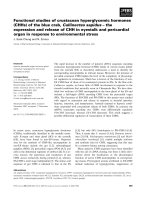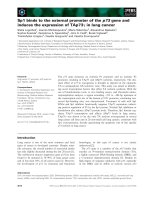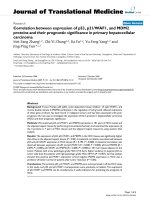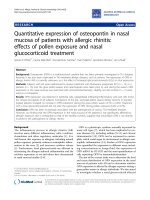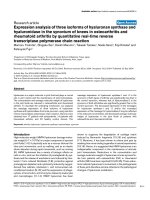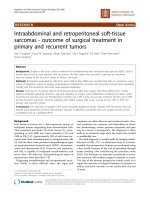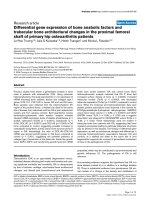Fluctuating expression of miR-584 in primary and high-grade gastric cancer
Bạn đang xem bản rút gọn của tài liệu. Xem và tải ngay bản đầy đủ của tài liệu tại đây (1.47 MB, 12 trang )
Ebrahimi Ghahnavieh et al. BMC Cancer
(2020) 20:621
/>
RESEARCH ARTICLE
Open Access
Fluctuating expression of miR-584 in
primary and high-grade gastric cancer
Laleh Ebrahimi Ghahnavieh1, Hossein Tabatabaeian2,3*, Zhaleh Ebrahimi Ghahnavieh4,
Mohammad Amin Honardoost2, Mansoureh Azadeh5, Mohamad Moazeni Bistgani6 and Kamran Ghaedi2,7*
Abstract
Background: Gastric cancer is the fifth most common cancer worldwide. Along with environmental factors, such as
Helicobacter pylori (H. pylori) infection, genetic changes play important roles in gastric tumor formations. miR-584 is
a less well-characterized microRNA (miRNA), with apparent activity in human cancers. However, miR-584 expression
pattern in gastric cancer development has remained unclear. This study aims to analyze the expression of miR-584
in gastric cancer samples and investigates the associations between this miRNA and H. pylori infection and clinical
characteristics.
Methods: The expression level of miR-584 was studied in primary gastric cancers versus healthy control gastric
mucosa samples using the RT-qPCR method. The clinical data were analyzed statistically in terms of miR-584
expression. In silico studies were employed to study miR-584 more broadly in order to assess its expression and
find new potential target genes.
Results: Both experimental and in silico studies showed up-regulation of miR-584 in patients with gastric cancer.
This up-regulation seems to be induced by H. pylori infection since the infected samples showed increased levels of
miR-584 expression. Deeper analyses revealed that miR-584 undergoes a dramatic down-regulation in late stages,
invasive and lymph node-metastatic gastric tumors. Bioinformatics studies demonstrated that miR-584 has a
substantial role in cancer pathways and has the potential to target STAT1 transcripts. Consistent with the inverse
correlation between TCGA RNA-seq data of miR-584 and STAT1 transcripts, the qPCR analysis showed a significant
negative correlation between these two RNAs in a set of clinical samples.
Conclusion: miR-584 undergoes up-regulation in the stage of primary tumor formation; however, becomes downregulated upon the progression of gastric cancer. These findings suggest the potential of miR-584 as a diagnostic
or prognostic biomarker in gastric cancer.
Keywords: Gastric cancer, miR-584, Helicobacter pylori, Computational analysis
* Correspondence: ;
2
Department of Cell and Molecular Biology and Microbiology, Faculty of
Biological Science and Technology, University of Isfahan, Isfahan, Iran
Full list of author information is available at the end of the article
© The Author(s). 2020 Open Access This article is licensed under a Creative Commons Attribution 4.0 International License,
which permits use, sharing, adaptation, distribution and reproduction in any medium or format, as long as you give
appropriate credit to the original author(s) and the source, provide a link to the Creative Commons licence, and indicate if
changes were made. The images or other third party material in this article are included in the article's Creative Commons
licence, unless indicated otherwise in a credit line to the material. If material is not included in the article's Creative Commons
licence and your intended use is not permitted by statutory regulation or exceeds the permitted use, you will need to obtain
permission directly from the copyright holder. To view a copy of this licence, visit />The Creative Commons Public Domain Dedication waiver ( applies to the
data made available in this article, unless otherwise stated in a credit line to the data.
Ebrahimi Ghahnavieh et al. BMC Cancer
(2020) 20:621
Background
Gastric cancer, as the fifth most common malignancy, is
the third cause of cancer-related death worldwide in both
genders [1]. The pathogenesis of gastric cancer involves
both genetics and environmental parameters [2]. A declining trend of gastric cancer incidence over the last decades
obviously shows the significance of lifestyle, e.g. widespread
food refrigeration rather than salt as the main form of preservation [3], and environmental factors, such as Helicobacter pylori (H. pylori) eradication. H. pylori infection is one
of the noticeable correlated factors with gastric neoplasm
through modulating inflammatory signaling pathways in
the mucosa of the stomach. This infection can promote the
risk of gastric cancer more than six-fold [4, 5].
Genetically, microRNAs (miRNAs) are important molecules that are deregulated in gastric cancer [6–9]. miRNAs are an emerging class of non-coding RNAs
containing less than 24 nucleotides, which bind mainly
to the 3′-UTR of their target mRNAs. These molecules
play a role as post-transcriptional regulatory factors
through either mRNA degradation or transcriptional repression of the targeted mRNAs [10]. miRNAs contribute to determining cell fate by means of regulating
cellular processes such as proliferation and apoptosis
[11]. Inevitably, dysregulation of miRNAs displays their
association with various pathological effects, such as inflammatory process and precancerous lesions to malignancy progression [12, 13]. Notably, H. pylori infection
is one of the vital factors responsible for miRNA dysregulation through regulating the inflammatory mediators
[14–17]. miR-21 [18, 19], miR-25 [19], miR-93 [20],
miR-146a [21], miR-155 [22], miR-196 [23], miR-200b/c
[15, 24], miR-222 [25], miR-223 [20], miR-584 and miR1290 [26] are the well-known H. pylori-induced upregulated miRNAs, while let-7b [24, 27], miR-103 [24],
miR-370 [28], miR-371, miR-372, miR-373 [29], miR375 [24] and miR-449 [30] are the down-regulated ones.
More recently, miR-584 has been reported to be upregulated in intestinal metaplasia and human primary colon
cancer tissues, induced by the H. pylori infection. miR-584,
in turn, promotes the epithelial-mesenchymal transition
(EMT) via targeting FOXA1 gene [26]. Dysregulation of
miR-584 has been also reported in gastric cancer [31]. However, there is a scientific gap regarding the expression of
miR-584 in gastric cancer in the context of H. pylori infection. Therefore, the main aim of this study was to evaluate
the expression level of miR-584 in normal gastric mucosa
specimens along with malignant gastric mucosa tissue patients and analyze its association with H. pylori infection.
Methods
Patients and control samples
Tumor samples (n = 26) were obtained from the patients
undergoing gastrectomy surgery at Al-Zahra Hospital,
Page 2 of 12
Isfahan, Iran, and Kashani Hospital, Shahre Kord, Iran.
In addition, endoscopy samples (n = 11) were taken from
healthy volunteers and used as control samples. Immediately after obtaining tissue samples, they were submerged in a 2 ml RNase-free containing RNAlater™
Stabilization Solution (Ambion, Austin, Texas) and
transferred to a laboratory on ice for subsequent analyses. Before specimen collection, the stomach biopsies
were taken to detect H. pylori infection using Rapid Urease Detection test (HelicotecUT Plus, Taiwan) in both
patient and control groups. The normal/tumor status of
the samples was verified by four expert pathologists.
Ethically, the samples were collected in accordance with
the guidelines issued by the Ethics Committee of AlZahra Hospital, regarding 1964 Helsinki declaration.
Moreover, informed consent was gained from all studied
individuals. The characteristics of the samples including
age, sex and H. pylori infection are listed in Table 1.
RNA extraction
Total RNA from tissue specimens was extracted using
Hybrid-R™ miRNA kit (GeneAll, Seoul, South Korea).
The quality of extracted RNAs determined according to
260/280 absorbance ratio, measured by the NanoDrop
spectrometer (Thermo Scientific, USA). In order to remove potential DNA contamination, small RNA samples
underwent RNA-free DNase (TaKaRa, Japan) treatment.
cDNA synthesis and RT-qPCR
Normal cDNA synthesis was performed by RevertAid
Reverse Transcriptase (Thermofisher) according to the
manufacturer’s protocol. STAT1 primers were designed
with Oligo Primer Analysis software (DBA Oligo, Inc.)
as Forward: 5′-TGAACTTACCCAGAATGCCC-3′, and
Reverse: 5′-CAGACTCTCCGCAACTATAGTG-3′.
cDNA synthesis for miR-584 and U6 (reference control) was achieved by using a Universal cDNA Synthesis
Kit (Exiqon, Denmark), according to manufacturer’s instruction. Real-time quantitative PCR reactions were carried out in triplicate by using standard protocols with an
ABI PRISM 7500 instrument (Applied Biosystems,
USA). cDNA products were added to a master mix comprising 10 pmol/μl of each miR-584 and U6 primers
Table 1 Patient sample characteristics
Control (n = 11) Case (n = 26) p
Variable
Age (SD)
49.73 (21.45)
61.13 (13.54)
0.055 *
Woman
4
6
0.406 **
Man
7
20
H. pylori infection Negative 5
12
Sex
Positive
6
SD Standard deviation, H. pylori Helicobacter pylori
* Independent t-test
** Chi-square test
14
0.969 **
Ebrahimi Ghahnavieh et al. BMC Cancer
(2020) 20:621
(Exiqon, Denmark) and 2 U of SYBR premix ExTaq II
(TaKaRa, Japan). Real-time data were evaluated and reported based on 2-ΔΔCT method to calculate the fold
change in miR-584 expression among different groups.
The PCR program conditions were: 95 °C for 5 min
(min) followed by 40 cycles of 95 °C for 5 s (s), 60 °C for
20 s and 72 °C for 30 s.
Statistical analysis
All statistical analyses were performed by SPSS statistical
software, version 20.0 (SPSS Inc., Chicago, IL, USA).
ANOVA test was used and followed by analyzing with a
non-parametric Mann– Whitney post hoc test to evaluate
and assess the potential of miR-584 as a diagnostic indicator of disease severity to differentiate between gastric malignancy and normal tissue with regards to H. pylori infection.
Linear regression analysis was performed to analyze the relationship between stages and survival rates to miR-584 expression in human gastric cancers. Results were considered
as statistically significant at P values equal or less than 0.05.
In silico analyses
The TCGA data ( were analyzed to examine the expression levels of miR-584 in paired
tumor and adjacent control samples of stomach adenocarcinoma patients. Besides, ENCORI (starBase) publicly available online tool [32] was used to analyze the differential
expression of miR-584 in normal and tumor samples, and
also to analyze the correlation between miR-584 and its
host and predicted target genes. The KM Plotter database
was used to investigate the survival rate of clinical patients
in terms of the expression level of miR-584 [33].
In order to perform molecular enrichment analysis on
miR-584 targetome and to determine the signaling pathways that are statistically involved, we used several online databases of miRWalk [34] and miRTarBase [35, 36]
to achieve predicted and validated targets of miR-584
particularly. Next, using UniGene database (http://www.
ncbi.nlm.nih.gov/unigene/) and subsequent EST profile,
we investigated the filtered targetome expression in the
stomach and gastrointestinal tumors. Finally, miR-584
targetome expressed in stomach and gastrointestinal
tumor was assigned to the database for annotation,
visualization and integrated discovery (DAVID) online
bioinformatics database, version 6.7 [37] arranged with
Kyoto Encyclopedia of Genes and Genomes (KEGG)
pathway analysis [38] to recognize the most statistical
correlated signaling pathways and molecular networks
with miR-584 targetome.
Results
miR-584 is highly expressed in tumor samples
The expression level of miR-584 was determined by RTqPCR, followed by the statistical analysis in four groups,
Page 3 of 12
including patients with H. pylori infection (n = 14), patients without H. pylori infection (n = 12), control samples infected by H. pylori (n = 6) and non-infected
control samples (n = 5). The expression pattern of miR584 was normalized to U6. Primer specificity for miR584 and U6 was evaluated by agarose gel electrophoresis
(Supplementary Figure1). Our analyses revealed that
miR-584 expression was approximately 5.3 times higher
in gastric cancer cases as compared to the control samples (P < 0.001) (Fig. 1a). The differential expression of
miR-584 was further studied using publicly available online tools of TCGA and ENCORI. Analyzing the TCGA
data of stomach adenocarcinoma in the paired casecontrol samples significantly showed the upregulation of
miR-584 (adjusted P < 0.001) (Fig. 1b). Consistently, the
analysis of unpaired samples in ENCORI databased revealed significant and obvious higher expression of miR584 in the tumor samples (adjusted P < 0.001) (Fig. 1c).
Taken together, the in silico data strongly demonstrate
the overexpression of miR-584 overexpression in gastric
cancer samples, which has been validated in our study
on the clinical specimens. The TCGA data were further
studied to find whether miR-584 up-regulation is mediated by epigenetic alteration or amplification. First, we
demonstrated that miR-584 is located in the intronic region of SH3TC2 gene. The transcription of these two
genes might be regulated by the same promoter region
as SH3TC2 was also shown to be up-regulated in gastric
cancer (P = 1.7e-8) (Fig. 1d), which significantly and
strongly correlated with miR-584 in gastric (P = 1.79e75, r = 0.774) (Fig. 1e) and other panels of human cancers (Supplementary Figure 2). The TCGA gene copy
number analysis revealed that SH3TC2 gene upregulation is not mediated by gene amplification nor epigenetic alterations. These data collectively suggest that
SH3TC2 gene, and thereby its intronic miR-584, are upregulated in cancer probably in response to the higher
expression/activity of their transcription factors. The
ChIP-seq data obtained from the UCSC genome browser
showed that SH3TC2/miR-584 locus is regulated by cJun and c-Fos transcription factors, which are known
up-regulated oncoproteins in gastric cancer [39, 40].
miR-584 expression is affected by H. pylori infection
Dividing the samples in terms of H. pylori infection, the
data significantly showed a statistically elevated expression of miR-584 in the H. pylori-infected patients in
comparison with other groups including H. pylori-infected controls (P = 0.018), non-infected controls (P =
0.007) and H. pylori-negative patients (P = 0.011). However, there was no significant differences between the
miR-584 expression in H. pylori-negative patients and H.
pylori-infected controls (P = 0.609) or non-infected controls (P = 0.054) (Fig. 2a). Comparing the control
Ebrahimi Ghahnavieh et al. BMC Cancer
(2020) 20:621
Page 4 of 12
Fig. 1 a Analysis of miR-584 expression in the patient’s tumor versus normal tissue. b In silico analysis of miR-584 in paired TCGA clinical gastric
cancer and normal gastric mucosa samples. c In silico analysis of miR-584 in unpaired TCGA clinical gastric cancer samples. d Analysis of SH3TC2
expression in the patient’s tumor versus normal tissue. e Correlation between miR-584 and SH3TC2 expression gastric cancer samples.
*** P < 0.005
samples, although the expression of miR-584 increased
slightly in the H. pylori-infected samples, the difference
was not significant (P = 0.928) (Fig. 2a). Furthermore and
independent of tumor/control status, miR-584 was
expressed significantly higher in H. pylori-infected samples
as compared to non-infected ones, with approximately 2.6
fold change increase (P = 0.005) (Fig. 2b). To examine this
hypothesis in another cohort, the TCGA samples, that had
been recently tested for H. pylori infection using the
methods described in the Zhang et al. study [41], were then
analyzed in terms of miR-584 expression. Likewise, this
analysis displayed a significant correlation between H. pylori
Ebrahimi Ghahnavieh et al. BMC Cancer
(2020) 20:621
Page 5 of 12
Fig. 2 a Analysis of miR-584 expression in four H. pylori-categorized normal and tumor samples. b Analysis of miR-584 expression in H. pyloripositive and negative samples. c Analysis of miR-584 expression in H. pylori-categorized TCGA clinical samples. * P < 0.05, ** P < 0.01, *** P < 0.005
infection and miR-584 expression (P = 0.034) (Fig. 2c). Collectively, the findings suggest that the elevated expression
of miR-584 could be driven by H. pylori infection in gastric
cancer. It remains to be validated whether H. pylori infection can up-regulate miR-584 in gastric cancer based on
in vitro assays.
miR-584 does not correlate with the patients’
demographics
We then asked whether the expression of miR-584 correlates with the age, blood group or the sex of the studied patients. Our analyses showed no significant
correlation or association between either age (P = 0.309),
sex (P = 0.745) or blood groups (P = 0.774). Next, we interrogated whether miR-584 is associated with the clinical features of gastric cancer patients.
Association of miR-584 expression level and
clinicopathological factors
To delineate the clinical significance of miR-584, we analyzed the correlation between miR-584 levels and the
patient’s clinicopathological factors in greater detail. To
study the potential correlation with gastric cancer stages,
all tumor samples were reviewed by the pathologist after
Hematoxylin & Eosin (H&E) staining and were categorized into different clinical stages (I-IV) based on AJCC/
UICC Tumor Node Metastasis (TNM) staging system.
Interestingly, there was a significant difference between the expression level of miR-584 in different staging groups, including stage I and III (P = 0.048), I and
IV (P = 0.030), and II and IV (P = 0.038) (Fig. 3a). Furthermore, linear regression analyses showed that miR584 expression was negatively correlated with gastric
malignancy stages, in a way that the expression level of
Ebrahimi Ghahnavieh et al. BMC Cancer
(2020) 20:621
Page 6 of 12
Fig. 3 a Analysis of miR-584 in different gastric cancer stages. b Correlation of miR-584 and different stages of gastric cancer samples. c Analysis
of miR-584 expression in different gastric cancer stages of TCGA gastric cancer samples. d Analysis of miR-584 in lymph node-negative and
positive gastric tumors. e Analysis of miR-584 among tumors with different regional lymph node involvement. f Analysis of miR-584 expression
among gastric tumors with different depths of invasion. * P < 0.05, ** P < 0.01
this miRNA was higher in the early stages of gastric cancer and it decreased in the progression of malignancy
(P < 0.001, Spearman test) (Fig. 3b). The highthroughput analysis of TCGA data also revealed a similar trend, i.e. elevated miR-584 expression in early and
lower expression in the higher stages (Fig. 3c). These results suggest that this miRNA could be specifically a
cancer-promoting factor which undergoes downregulation during cancer progression. In line with this
finding, higher expression of miR-584 was shown to be
associated significantly with the absence of regional
lymph node metastases, in comparison with lymph node
metastatic samples (P = 0.005) (Fig. 3c). Interestingly, we
did find a significant difference of miR-584 expression in
Ebrahimi Ghahnavieh et al. BMC Cancer
(2020) 20:621
N0 level, as compared to N2 (P = 0.001) and N3 (P =
0.001). Additionally, the expression of miR-584 in N1
groups was different from N2 (P = 0.028) and N3 (P =
0.002). Nevertheless, there were no significant differences between N0 and N1 (P = 0.306) or N2 and N3
(P = 0.129) (Fig. 3d).
Moreover, evaluation of the miR-584 expression and
the degree of invasion to the gastric wall showed a
significant difference in T1 vs. T3 (P = 0.004) and T4
(P = 0.009); but not to T2 (P = 0.931). Furthermore, a significant different expression of miR-584 was observed
when comparing T2 to T3 (P = 0.021) and T4 (P =
0.003), and T3 to T4 (P = 0.008). (Fig. 3e). Collectively,
the miR-584 expression pattern reveals that this small
non-coding RNA is highly expressed upon the formation
of gastric tumors. However, its regulation declines significantly with the progression of cancer.
These provocative findings prompted us to check
whether miR-584 correlates with the higher survival rate
of the patients. Linear regression analysis revealed clear
segregation of survival rates between the four staging
groups (Fig. 4a). The regression curve demonstrates a
strong correlation between miR-584 level and 5-year
survival rate of the patients. To assess this finding in a
larger population, KM Plotter online tool was used. Analyzing the survival rate of 431 stomach adenocarcinoma
patients clearly showed that higher expression of miR584 is correlated with lower overall survival of the patients (Log rank P = 0.05, hazard ratio = 0.72, 95% CI:
0.50–1.03) (Fig. 4b). Further analyses revealed that patients with a higher expression of miR-584 survived for
median of 56.2 months, while the patients with a low expression only survived for a median of 26.7 months.
More interestingly, studying the patients with stage IV
of adenocarcinoma showed a greater effect of miR-584
expression (Log rank P = 0.032, hazard ratio = 0.32, 95%
CI: 0.11–1.96) (Fig. 4c). Hypothetically, although miR584 is dramatically up-regulated in primary gastric tumors, it undergoes down-regulation upon the progression of cancer, contributing to the higher stages and
lower survival of the patients. The schematic proposed
role of miR-584 in gastric cancer initiation and progression is shown in Fig. 4d.
Computational analysis of miR-584 targetome proposed a
possible inducing role of miR-584 in cancer
To help define how miR-584 may be related to gastric
cancer, molecular signaling pathway enrichment analysis
as already described in the materials and methods was
performed. Using miRTarBase and miRwalk databases,
112 and 1552 mRNAs were specified as validated and
predicted targets of miR-584, respectively (data not
shown). Among the list, 65 validated and 670 predicted
mRNA targets were reported to be expressed in stomach
Page 7 of 12
and gastrointestinal tumors, achieved from the UniGene
database. These target genes were selected as miR-584
targetome for further molecular enrichment analysis.
Imputing Entrez IDs as official gene symbols of selected
miR-584 targetome into the functional annotation tool
of DAVID determined the statistically significant association of imputed genes with several KEGG signaling
pathways. The set of imputed genes representing the
miR-584 targetome was chiefly associated with several
KEGG signaling pathways showing that target genes
were significantly involved in cancer pathways and other
oncogenic/tumor suppressor transduction systems including Wnt signaling, TGF-β signaling, adherence junction and VEGF signaling pathways (Table 2). The
enriched KEGG pathways in cancer are shown in Supplementary Figure 3. Interestingly, among these targets,
EST1 and MAPK1 are validated targets of miR-584 as
reported by experimental technology evidence. STAT1,
PTEN, CCND1 and PIK3CA genes were among the topscore unvalidated miR-584 targetome. In silico correlation analysis performed via ENCORI database revealed
that there were significant inverse correlations between
miR-584 and these transcripts (Fig. 5a-d). STAT1 was
selected for correlation analysis in 10 gastric cancer and
5 normal gastric mucosa in-house clinical samples due
to its highest r value. Interestingly, qPCR analysis and
Spearman’s correlation test showed a significant negative
correlation between miR-584 and STAT1 transcript expression (r = − 0.551, P = 0.033) (Fig. 5e). Taken together,
miR-584 may have an unvalidated cancer-related targetome that includes PTEN, CCND1, PIK3CA and STAT1.
The latter showed a negative correlation in both TCGA
and in-house clinical samples. The end-point in vitro validation using luciferase reported assay remains to be performed to validate the predicted targetome of miR-584.
Discussion
There are emerging reports pertaining to the pathogenesis capabilities of miRNAs in cancer. Such studies have
demonstrated the great importance of miRNAs as diagnostic/prognostic biomarkers with therapeutic potential.
Among several miRNAs, a number of studies reported
the association between miR-584 with different cancers
such as lung [42], breast [43] and neuroblastoma [44].
Consistent with these findings, miR-584 may contribute
to other malignancies such as gastric cancer.
In an effort to elucidate the role of miR-584 in gastric
cancer - for the first time and to the best of our knowledge - we performed a case-control study and evaluated
miR-584 expression level in 26 cases and 11 controls of
the non-neoplastic gastric mucosa. Furthermore, in silico
analyses obtained by the publicly available online tools
were employed to assess the key findings.
Ebrahimi Ghahnavieh et al. BMC Cancer
(2020) 20:621
Page 8 of 12
Fig. 4 a Survival analysis of miR-584 expression in four different gastric tumor stages. b In silico survival analysis of miR-584 expression in clinical
gastric cancer subjects. c In silico survival analysis of miR-584 expression in patients with stage IV of gastric cancer. d Proposed schematic of miR584 expression pattern in gastric cancer development
Analysis of the expression of miR-584 in gastric tumor
and healthy stomach tissues showed that miR-584 is significantly up-regulated in the primary gastric cancer tissues. The in silico studies on the paired and unpaired
samples significantly displayed the miR-584 expression
in gastric cancer patients. We further analyzed the inhouse and TCGA data and showed that the up-
regulation of miR-584 could be mediated by H. pylori infection since the infected samples showed higher expression of miR-584 significantly. Interestingly, the known
H. pylori-induced transcription factors, c-Jun and c-Fos
[45, 46], were shown to be the potential miR-584 transcription drivers. Collectively, we propose H. pylori ➔ cJun/c-Fos ➔ miR-584 route as a proposed mechanistic
Ebrahimi Ghahnavieh et al. BMC Cancer
(2020) 20:621
Page 9 of 12
Table 2 Top statistically related signaling pathways to miR-584 targetome obtained from KEGG database through DAVID tool
Rank
KEGG Pathway
Number of genes (%)
P*
1
Pathways in cancer
21 (2.9)
5.4E2
2
Regulation of actin cytoskeleton
19 (2.6)
3.4E3
3
Focal adhesion
17 (2.4)
9.1E3
4
Ubiquitin mediated proteolysis
15 (2.1)
1.6E3
5
Chemokine signaling pathway
14 (1.9)
4.7E2
6
Endocytosis
13 (1.8)
8.1E2
7
Fc gamma Rmediated phagocytosis
12 ()
1.8E3
8
Chronic myeloid leukemia
11 (1.7)
9.9E4
9
Insulin signaling pathway
11 (1.5)
5.4E2
10
Wnt signaling pathway
11 (1.5)
9.8E2
11
Pancreatic cancer
10 (1.4)
2.8E3
12
Adherens junction
10 (1.4)
4.4E3
13
Vascular smooth muscle contraction
9 (1.2)
9.4E2
14
Colorectal cancer
9 (1.2)
2.3E2
15
TGFbeta signaling pathway
9 (1.2)
2.8E2
16
Oocyte meiosis
9 (1.2)
8.7E2
17
Longterm potentiation
8 (1.1)
2.2E2
18
Phosphatidylinositol signaling system
8 (1.1)
3.4E2
19
Endometrial cancer
7 (1)
2.0E2
20
Acute myeloid leukemia
7 (1)
3.3E2
21
Melanoma
7 (1)
7.4E2
22
B cell receptor signaling pathway
7 (1)
9.1E2
23
VEGF signaling pathway
7 (1)
9.1E2
24
Nonsmall cell lung cancer
6 (0.8)
7.3E2
25
Dorsoventral axis formation
4 (0.6)
8.4E2
* The threshold of EASE score, a modified Fisher Exact P-value, for gene-enrichment analysis
route of miR-584 up-regulation in gastric cancer. This
hypothesis remained to be further studied and validated
by in vitro biochemical experiments.
Despite the miR-584 expression up-regulation in gastric cancer patients, the analyses of low versus highgrade tumor samples clearly showed that the expression
of miR-584 undergoes down-regulation upon the progression of gastric cancer. miR-584 has indeed lower expression in higher stages, invasive and lymph node
metastatic samples. Interestingly, the bioinformatics
studies on the survival rate of gastric cancer subjects reveal that the patients with higher expression of miR-584
survived for a longer time. These findings suggest that
miR-584 overexpression might be required for gastric
tumorigenesis, while it has to be down-regulated upon
tumor progression. Further in vitro biochemical studies
are highly recommended through which the biological
functions such as cell growth and invasion of gastric
cancer cell lines can be examined upon miR-584 overexpression and downregulation. Narasimhan et al. reported
the up-regulation of miR-584 in colorectal cancer.
Interestingly, the higher expression of this miRNA was
only observed in colon adenoma and not carcinoma. In
line with our findings, this study supports that miR-584
overexpression is only required for the primary levels of
tumorigenesis [47].
As discussed before, we showed that there is a significantly higher miR-584 expression in H. pylori-infected
samples, especially in tumors. Consistent with our finding, Zhu et al. demonstrated the NFκB-mediated upregulation of miR-584 in response to H. pylori infection,
which in turn resulted in the induction of intestinal
metaplasia of gastric epithelial cells [26]. Furthermore,
miR-584 up-regulation could also be driven in Porphyromonas gingivalis infection and inflammatory diseases
[48, 49]. These findings strongly indicate that miR-584
could be an important downstream target of inflammatory and pathogenic stimuli, contributing to stomach
tumorigenesis. Performing in-situ hybridization of miR584 in the sections including proper gastric gland, intestinal metaplasia and gastric cancer tissue can further
prove this finding.
Ebrahimi Ghahnavieh et al. BMC Cancer
(2020) 20:621
Page 10 of 12
Fig. 5 In silico correlation of miR-584 and (a) STAT1, (b) CCND1, (c) PIK3CA and (d) PTEN expression levels in TCGA samples. e Correlation of
miR-584 and STAT1 expression levels in 5 normal gastric mocusa and 10 gastric cancer clinical samples
Controversially, Li et al. reported that miR-584 plays a
role as a tumor suppressor miRNA in gastric cancer. In
this study, the down-regulation of miR-584 was shown
and the biochemical in vitro studies revealed that miR-584
inhibits the proliferation rate via targeting WW domaincontaining E3 ubiquitin-protein ligase 1 (WWP1), which
triggers the TGF-β signaling pathway [31]. However, they
did not clearly specify the stage/grade, and more
importantly, the status of H. pylori infection of the studied
samples.
Although some miR-584 target transcripts have been
validated, such as WWP1 and ROCK1 [50], many other
potential targets are yet to be studied. Our in silico investigations have introduced a new subset of genes that
can be potentially targeted by miR-584. Among them,
STAT1, PTEN, PI3K and cyclin D1 are the most
Ebrahimi Ghahnavieh et al. BMC Cancer
(2020) 20:621
interesting targets. Our in silico analysis showed a significant negative correlation between miR-584 and either
of the genes. The negative correlation of miR-584 and
STAT1 was further validated by analyzing 15 samples
using qPCR method. These genes have remained to be
validated by biochemical in vitro studies in the future.
This can be achieved by cloning the 3’UTR of the genes
downstream of luciferase and investigate the luciferase
activity upon overexpression or knockdown of miR-584.
Conclusion
miR-584 has a fluctuating expression level in a normal stomach, primary tumors and progressed gastric cancer. This
miRNA undergoes up-regulation in the early stages of primary tumor formation; however, it becomes down-regulated
upon the progression of gastric cancer. These findings
propose the potential of miR-584 as a diagnostic biomarker
for early detection of gastric cancer and a prognostic factor
to predict the clinical outcomes of the patients. The former
can be studied by analyzing the miR-584 in the serum or saliva of gastric cancer and healthy individuals to determine
whether this dysregulated molecule could serve as a diagnostic circulating miRNA in high-risk people.
Supplementary information
Supplementary information accompanies this paper at />1186/s12885-020-07116-5.
Additional file 1 Supplementary Figure 1. Analysis of RT-qPCR products of miR-584 and U6 primers separated by agarose gel electrophoresis.
Additional file 2 Supplementary Figure 2. Correlation between miR584 and SH3TC2 expression in a panel of human cancers including (A)
brain lower grade glioma, (B) head and neck squamous cell carcinoma,
(C) lung squamous cell carcinoma, (D) kidney renal papillary cell carcinoma, (E) skin cutaneous melanoma and (F) lung adenocarcinoma.
Additional file 3 Supplementary Figure 3. miR-584 targetome is involved in several important pathways including cancer pathways as well
as Wnt signaling, TGF-beta signaling, adherence junction and VEGF signaling pathways, ranked as top related signaling pathways. The diagram
collected from KEGG pathway. The unvalidated potential targets of miR584 are marked by red asterisks.
Abbreviations
ChIP: Chromatin Immunoprecipitation; DAVID: Database for Annotation,
Visualization and Integrated Discovery; EMT: Epithelial-mesenchymal
Transition; ENCORI: The Encyclopedia of RNA Interactomes; FOXA1: Forkhead
Box A1; Helicobacter pylori: H. pylori; H&E staining: Hematoxylin & Eosin
staining; KEGG: Kyoto Encyclopedia of Genes and Genomes; KM: Kaplan
Meier; MAP K1: Mitogen-Activated Protein Kinase 1; microRNAs: MiRNAs;
NFκB: Nuclear Factor Kappa B Subunit; PI3K: Phosphatidylinositol-4,5Bisphosphate 3-Kinase; ROCK1: Rho Associated Coiled-Coil Containing Protein
Kinase 1; RT-qPCR: Reverse Transcriptase quantitative PCR; SH3TC2: SH3
Domain and Tetratricopeptide Repeats 2; STAT1: Signal Transducer and
Activator of Transcription 1; TCGA: The Cancer Genome Atlas; TGFβ: Ransforming Growth Factor Beta; TNM: Tumor Node Metastasis;
VEGF: Vascular Endothelial Growth Factor; WWP1: WW domain-containing E3
ubiquitin-protein ligase 1.
Acknowledgments
The authors send their gratitude regards to Dr. Kamran Tahmasbi,
(Department of Pathology, Faculty of Medicine, Shahrekord University of
Page 11 of 12
Medical Sciences, Shahrekord, Iran) for providing of gastric cancer samples
and identification of gastric cancer stages.
Authors’ contributions
HT and KG participated in the conception and design of the study. LEG
performed the experiments including RNA extraction, cDNA synthesis and
qPCR. LEG, ZEG and HT performed the qPCR results and statistical data
analyses. MAH and HT performed bioinformatics analyses. MA and MMB
provided the clinical samples and experimental facilities. LEG drafted the
paper. LEG and HT participated in the final preparation and revision of the
paper. All authors read and approved this final manuscript.
Funding
Not applicable.
Availability of data and materials
The data analyzed in this study will not be shared due to the policy of the
Ethics Committee.
Ethics approval and consent to participate
Ethical approval for this study was obtained from the Ethics Committee of
Al-Zahra Hospital/Isfahan University of Medical Sciences, regarding 1964
Helsinki declaration. Written informed consent was obtained from all subjects
before the study.
Consent for publication
Not applicable.
Competing interests
The authors declare that they have no competing interests.
Author details
Department of Biology, Tehran-east Payame Noor University, Tehran, Iran.
2
Department of Cell and Molecular Biology and Microbiology, Faculty of
Biological Science and Technology, University of Isfahan, Isfahan, Iran.
3
Anahid Cancer Clinic, Isfahan Healthcare City, Isfahan, Iran. 4Department of
Medical Education, Faculty of Medicine, Shahrekord University of Medical
Sciences, Shahrekord, Iran. 5Zist-Fanavari Novin Biotechnology Institute,
Isfahan, Iran. 6Department of Surgery, Faculty of Medicine, Shahrekord
University of Medical Sciences, Shahrekord, Iran. 7Department of Cellular
Biotechnology, Cell Science Research Center, Royan Institute for
Biotechnology, ACECR, Isfahan, Iran.
1
Received: 28 October 2019 Accepted: 25 June 2020
References
1. Bray F, Ferlay J, Soerjomataram I, Siegel RL, Torre LA, Jemal A. Global cancer
statistics 2018: GLOBOCAN estimates of incidence and mortality worldwide
for 36 cancers in 185 countries. CA Cancer J Clin. 2018;68(6):394–424.
2. Arnold M, Karim-Kos HE, Coebergh JW, Byrnes G, Antilla A, Ferlay J, Renehan
AG, Forman D, Soerjomataram I. Recent trends in incidence of five common
cancers in 26 European countries since 1988: Analysis of the European
Cancer observatory. Eur J Cancer. 2013;51(9):1164-87.
3. Park B, Shin A, Park SK, Ko K-P, Ma SH, Lee E-H, Gwack J, Jung E-J, Cho LY,
Yang JJ. Ecological study for refrigerator use, salt, vegetable, and fruit
intakes, and gastric cancer. Cancer Causes Control. 2011;22(11):1497.
4. Kuipers E. Review article: exploring the link between helicobacter pylori and
gastric cancer. Aliment Pharmacol Ther. 1999;13(s1):3–11.
5. Suerbaum S, Michetti P. Helicobacter pylori infection. N Engl J Med. 2002;
347(15):1175–86.
6. Adami B, Tabatabaeian H, Ghaedi K, Talebi A, Azadeh M, Dehdashtian E.
miR-146a is deregulated in gastric cancer. J Cancer Res Ther. 2019;15(1):108.
7. Noormohammad M, Sadeghi S, Tabatabaeian H, Ghaedi K, Talebi A, Azadeh
M, Khatami M, Heidari MM. Upregulation of miR-222 in both helicobacter
pylori-infected and noninfected gastric cancer patients. J Genet. 2016;95(4):
991–5.
8. Hao N-B, He Y-F, Li X-Q, Wang K, Wang R-L. The role of miRNA and lncRNA
in gastric cancer. Oncotarget. 2017;8(46):81572.
Ebrahimi Ghahnavieh et al. BMC Cancer
9.
10.
11.
12.
13.
14.
15.
16.
17.
18.
19.
20.
21.
22.
23.
24.
25.
26.
27.
28.
29.
30.
(2020) 20:621
Dehdashtian E, Tabatabaeian H, Ghaedi K, Talebi A, Adami B. A H. pyloriindependent miR-21 overexpression in gastric cancer patients. Gene
Reports. 2019;17:100528.
Bartel DP. MicroRNAs: target recognition and regulatory functions. Cell.
2009;136(2):215–33.
da Silva Oliveira KC, Araújo TMT, Albuquerque CI, Barata GA, Gigek CO, Leal
MF, Wisnieski F, Junior FARM, Khayat AS, de Assumpção PP. Role of miRNAs
and their potential to be useful as diagnostic and prognostic biomarkers in
gastric cancer. World J Gastroenterol. 2016;22(35):7951.
Lu J, Getz G, Miska EA, Alvarez-Saavedra E, Lamb J, Peck D, Sweet-Cordero
A, Ebert BL, Mak RH, Ferrando AA. MicroRNA expression profiles classify
human cancers. Nature. 2005;435(7043):834–8.
Oertli M, Engler DB, Kohler E, Koch M, Meyer TF, Müller A. MicroRNA-155 is
essential for the T cell-mediated control of helicobacter pylori infection and for
the induction of chronic gastritis and colitis. J Immunol. 2011;187(7):3578–86.
Chen L, Yang Q, Kong WQ, Liu T, Liu M, Li X, Tang H. MicroRNA-181b
targets cAMP responsive element binding protein 1 in gastric
adenocarcinomas. IUBMB Life. 2012;64(7):628–35.
Baud J, Varon C, Chabas S, Chambonnier L, Darfeuille F, Staedel C.
Helicobacter pylori initiates a mesenchymal transition through ZEB1 in
gastric epithelial cells. PLoS One. 2013;8(4):e60315.
Liu X, Ru J, Zhang J, L-h Z, Liu M, Li X, Tang H. miR-23a targets interferon
regulatory factor 1 and modulates cellular proliferation and paclitaxel-induced
apoptosis in gastric adenocarcinoma cells. PLoS One. 2013;8(6):e64707.
Baltimore D, Boldin MP, O'Connell RM, Rao DS, Taganov KD. MicroRNAs:
new regulators of immune cell development and function. Nat Immunol.
2008;9(8):839–45.
Zhang Z, Li Z, Gao C, Chen P, Chen J, Liu W, Xiao S, Lu H. miR-21 plays a
pivotal role in gastric cancer pathogenesis and progression. Lab Investig.
2008;88(12):1358–66.
Belair C, Darfeuille F, Staedel C. Helicobacter pylori and gastric cancer:
possible role of microRNAs in this intimate relationship. Clin Microbiol
Infect. 2009;15(9):806–12.
Matsushima K, Isomoto H, Inoue N, Nakayama T, Hayashi T, Nakayama M,
Nakao K, Hirayama T, Kohno S. MicroRNA signatures in helicobacter pyloriinfected gastric mucosa. Int J Cancer. 2011;128(2):361–70.
Zhou L, Zhao X, Han Y, Lu Y, Shang Y, Liu C, Li T, Jin Z, Fan D, Wu K.
Regulation of UHRF1 by miR-146a/b modulates gastric cancer invasion and
metastasis. FASEB J. 2013;27(12):4929–39.
Xiao B, Liu Z, Li B-S, Tang B, Li W, Guo G, Shi Y, Wang F, Wu Y, Tong W-D.
Induction of microRNA-155 during helicobacter pylori infection and its negative
regulatory role in the inflammatory response. J Infect Dis. 2009;200(6):916–25.
Shiotani A, Uedo N, Iishi H, Murao T, Kanzaki T, Kimura Y, Kamada T,
Kusunoki H, Inoue K, Haruma K. H. Pylori eradication did not improve
dysregulation of specific oncogenic miRNAs in intestinal metaplastic glands.
J Gastroenterol. 2012;47(9):988–98.
Isomoto H, Matsushima K, Inoue N, Hayashi T, Nakayama T, Kunizaki M,
Hidaka S, Nakayama M, Hisatsune J, Nakashima M. Interweaving microRNAs
and proinflammatory cytokines in gastric mucosa with reference to H. pylori
infection. J Clin Immunol. 2012;32(2):290–9.
Li N, Tang B, Zhu E-D, B-s L, Zhuang Y, Yu S, D-s L, Zou Q-M, Xiao B, Mao XH. Increased miR-222 in H. pylori-associated gastric cancer correlated with
tumor progression by promoting cancer cell proliferation and targeting
RECK. FEBS Lett. 2012;586(6):722–8.
Zhu Y, Jiang Q, Lou X, Ji X, Wen Z, Wu J, Tao H, Jiang T, He W, Wang C.
MicroRNAs up-regulated by CagA of helicobacter pylori induce intestinal
metaplasia of gastric epithelial cells. PLoS One. 2012;7(4):e35147.
G-g T, Wang W-h, Dai Y, S-j W, Y-x C, Li J. let-7b is involved in the
inflammation and immune responses associated with helicobacter pylori
infection by targeting toll-like receptor 4. PLoS One. 2013;8(2):e56709.
Feng Y, Wang L, Zeng J, Shen L, Liang X, Yu H, Liu S, Liu Z, Sun Y, Li W.
FoxM1 is overexpressed in helicobacter pylori–induced gastric
carcinogenesis and is negatively regulated by miR-370. Mol Cancer Res.
2013;11(8):834–44.
Belair C, Baud J, Chabas S, Sharma CM, Vogel J, Staedel C, Darfeuille F.
Helicobacter pylori interferes with an embryonic stem cell micro RNA
cluster to block cell cycle progression. Silence. 2011;2(1):7.
Kheir TB, Futoma-Kazmierczak E, Jacobsen A, Krogh A, Bardram L,
Hother C, Grønbæk K, Federspiel B, Lund AH, Friis-Hansen L. miR-449
inhibits cell proliferation and is down-regulated in gastric cancer. Mol
Cancer. 2011;10(1):1.
Page 12 of 12
31. Li Q, Li Z, Wei S, Wang W, Chen Z, Zhang L, Chen L, Li B, Sun G, Xu J.
Overexpression of miR-584-5p inhibits proliferation and induces apoptosis
by targeting WW domain-containing E3 ubiquitin protein ligase 1 in gastric
cancer. J Exp Clin Cancer Res. 2017;36(1):59.
32. Li J-H, Liu S, Zhou H, Qu L-H, Yang J-H. starBase v2. 0: decoding miRNAceRNA, miRNA-ncRNA and protein–RNA interaction networks from largescale CLIP-Seq data. Nucleic Acids Res. 2013;42(D1):D92–7.
33. Nagy Á, Lánczky A, Menyhárt O, Győrffy B. Validation of miRNA prognostic
power in hepatocellular carcinoma using expression data of independent
datasets. Sci Rep. 2018;8(1):9227.
34. Dweep H, Gretz N. miRWalk2. 0: a comprehensive atlas of microRNA-target
interactions. Nature methods. 2015;12(8):697.
35. Hsu S-D, Tseng Y-T, Shrestha S, Lin Y-L, Khaleel A, Chou C-H, Chu C-F,
Huang H-Y, Lin C-M, Ho S-Y. miRTarBase update 2014: an information
resource for experimentally validated miRNA-target interactions. Nucleic
Acids Res. 2014;42(D1):D78–85.
36. Chou C-H, Chang N-W, Shrestha S, Hsu S-D, Lin Y-L, Lee W-H, Yang C-D, Hong
H-C, Wei T-Y, Tu S-J. miRTarBase 2016: updates to the experimentally validated
miRNA-target interactions database. Nucleic Acids Res. 2015:gkv1258.
37. Huang DW, Sherman BT, Lempicki RA. Systematic and integrative analysis of
large gene lists using DAVID bioinformatics resources. Nat Protoc. 2009;4(1):44.
38. Kanehisa M, Goto S. KEGG: Kyoto encyclopedia of genes and genomes.
Nucleic Acids Res. 2000;28(1):27–30.
39. Jin SP, Kim JH, Kim MA, Yang H-K, Lee HE, Lee HS, Kim WH. Prognostic
significance of loss of c-fos protein in gastric carcinoma. Pathol Oncol Res.
2007;13(4):284–9.
40. Peng Y, Zhang P, Huang X, Yan Q, Wu M, Xie R, Wu Y, Zhang M, Nan Q, Zhao
J. Direct regulation of FOXK1 by C-Jun promotes proliferation, invasion and
metastasis in gastric cancer cells. Cell Death Dis. 2016;7(11):–e2480.
41. Zhang C, Cleveland K, Schnoll-Sussman F, McClure B, Bigg M, Thakkar P,
Schultz N, Shah MA, Betel D. Identification of low abundance microbiome
in clinical samples using whole genome sequencing. Genome Biol. 2015;
16(1):265.
42. Hu L, Ai J, Long H, Liu W, Wang X, Zuo Y, Li Y, Wu Q, Deng Y. Integrative
microRNA and gene profiling data analysis reveals novel biomarkers and
mechanisms for lung cancer. Oncotarget. 2016;7(8):8441–54.
43. Fils-Aimé N, Dai M, Guo J, El-Mousawi M, Kahramangil B, Neel J-C, Lebrun JJ. MicroRNA-584 and the protein phosphatase and actin regulator 1
(PHACTR1), a new signaling route through which transforming growth
factor-β mediates the migration and actin dynamics of breast cancer cells. J
Biol Chem. 2013;288(17):11807–23.
44. Xiang X, Mei H, Qu H, Zhao X, Li D, Song H, Jiao W, Pu J, Huang K, Zheng L.
miRNA-584-5p exerts tumor suppressive functions in human neuroblastoma
through repressing transcription of matrix metalloproteinase 14. Biochim
Biophys Acta. 2015;1852(9):1743–54.
45. Sepulveda A, Tao H, Carloni E, Sepulveda J, Graham D, Peterson L. Screening of
gene expression profiles in gastric epithelial cells induced by helicobacter
pylori using microarray analysis. Aliment Pharmacol Ther. 2002;16:145–57.
46. Meyer-ter-Vehn T, Covacci A, Kist M, Pahl HL. Helicobacter pylori activates
mitogen-activated protein kinase cascades and induces expression of the
proto-oncogenes c-fos and c-Jun. J Biol Chem. 2000;275(21):16064–72.
47. Narasimhan K, Gauthaman K, Pushparaj PN, Meenakumari G, Chaudhary
AGA, Abuzenadah A, Gari MA, Al Qahtani M, Manikandan J. Identification of
unique miRNA biomarkers in colorectal adenoma and carcinoma using
microarray: evaluation of their putative role in disease progression. ISRN Cell
Biol. 2014;2014:1-10.
48. Ouhara K, Savitri IJ, Fujita T, Kittaka M, Kajiya M, Iwata T, Miyagawa T,
Yamakawa M, Shiba H, Kurihara H. miR-584 expressed in human gingival
epithelial cells is induced by Porphyromonas gingivalis stimulation and
regulates interleukin-8 production via lactoferrin receptor. J Periodontol.
2014;85(6):e198–204.
49. Zhong S, Zhang S, Bair E, Nares S, Khan AA. Differential expression of
microRNAs in normal and inflamed human pulps. J Endod. 2012;38(6):746–52.
50. Xiang J, Wu Y, Li D-S, Wang Z-Y, Shen Q, Sun T-Q, Guan Q, Wang Y-J. miR584 suppresses invasion and cell migration of thyroid carcinoma by
regulating the target oncogene ROCK1. Oncol Res Treat. 2015;38(9):436–40.
Publisher’s Note
Springer Nature remains neutral with regard to jurisdictional claims in
published maps and institutional affiliations.


